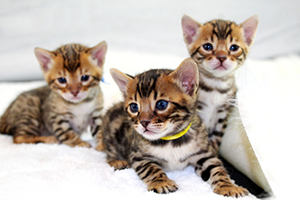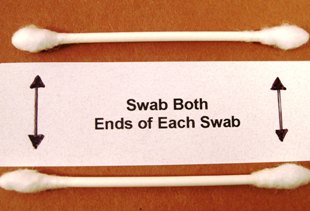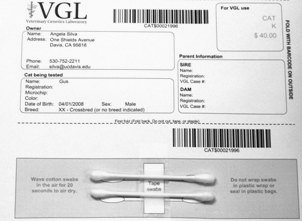Quick Summary
Click here for Price and Turnaround Time
Phenotype: Bengal progressive retinal atrophy is characterized by progressive blindness. The loss of the cells begins around 7 weeks of age and slowly progresses until the cat has very compromised vision by approximately 2 years of age. Blind cats tend to have more difficulty at night, sometimes becoming more vocal and more attached to their owners. The pupils are usually more dilated for affected cats than for cats with normal vision in the same lighting conditions. Affected cats also tend to carry their whiskers in a more forward position.
Mode of Inheritance: Autosomal recessive
Alleles: N = Normal/Unaffected, PRA = Progressive retinal atrophy
Breeds appropriate for testing: Bengal, Savannah Cat, Toyger, Highlander
Explanation of Results:
- Cats with N/N genoytpe will not have Bengal progressive retinal atrophy and cannot transmit this PRA-b variant to their offspring.
- Cats with N/PRA genotype will not have Bengal progressive retinal atrophy, but are carriers. Matings between two carriers are predicted to produce 25% kittens affected by PRA-b.
- Cats with PRA/PRA genotype will have Bengal progressive retinal atrophy, a condition leading to blindness in Bengal cats, and will transmit this PRA-b variant to all of their offspring.
$44 one test per animal
$66 this test + PK Deficiency test
Cat DNA tests are carried out using cells brushed from your cat's cheeks and gums using household cotton swabs.
The cat DNA submission form with instructions and a place to tape the cotton swabs is sent to you via email after you place an order, and can be printed from your home computer. DNA test kits are no longer mailed.
Instructions
Step-By-Step:
1.
 Purchase regular household cotton swabs for cat DNA collection (the cotton swabs can be purchased at a pharmacy or drug store)
Purchase regular household cotton swabs for cat DNA collection (the cotton swabs can be purchased at a pharmacy or drug store)
2.

Make sure the cat has not had anything to eat or drink for at least 1 hour prior to collecting sample.
When swabbing kittens, isolate each kitten from the mother, littermates and any shared toys for 1 hour prior to swabbing. Kittens should not have nursed or eaten for 1 hour prior to collecting sample.
If collecting samples from more than one cat, make sure to sample one cat at a time and wash your hands before swabbing another cat.
3.
 Use both ends of the two cotton swabs for a total of four swabs.
Use both ends of the two cotton swabs for a total of four swabs.
4.
Place the cotton head of the swab between the cat’s gums and cheek and rub or rotate the swab back and forth for 15 seconds. Repeat with each cotton swab head, for a total of 4 swabs. We recommend swabbing a different area of the gums with each swab head.
5.
Wave the swab in the air for 10-15 seconds to air dry it before attaching it to the submission form.
6.
 After swabbing the cheek and gums, tape the cotton swabs to the bar-coded submission form printed from your MyVGL account.
After swabbing the cheek and gums, tape the cotton swabs to the bar-coded submission form printed from your MyVGL account.
ATTENTION:
- Do not collect saliva/drool – the key to obtaining a good sample is getting cheek cells on the swab.
- Do not rub swab on the cat’s tongue or teeth – this will result in poor quality sample.
- Do not collect a sample from a kitten that has recently nursed – the mother’s genetic material can rub off on the kitten’s mouth and contaminate the sample.
The Veterinary Genetics Laboratory at the University of California, Davis in collaboration with the Lyons Feline Genetics and Comparative Medicine Laboratory at the University of Missouri discovered the genetic test for progressive retinal atrophy (PRA), which causes an autosomal recessive blindness in Bengal cats. The disease causes the destruction of the cells that register light (photoreceptors) in the back of the eye (the retina). The loss of the cells begins around 7 weeks of age and slowly progresses until the cat has very compromised vision by approximately 2 years of age. However, blindness develops at different rates in different cats. We have examples of cats over 2 years of age chasing a laser pointer; however vision testing by an ophthalmologist indicated that the cats should be blind. Blind cats tend to have more difficulty at night, sometimes becoming more vocal and more attached to their owners. The pupils are usually more dilated for affected cats than for cats with normal vision in the same lighting conditions. Affected cats also tend to carry their whiskers in a more forward position. Once affected cats know their surroundings, they are very mobile and active. Our thanks to the breeders who came forward and helped us establish a colony so that we could define the condition and find the gene responsible for this defect.
The causative DNA variant appears to be novel to the Bengal breed and occurred early in a popular lineage of the Bengals. We expect Bengal cats worldwide to have the condition and we have had reports of affected cats in the United Kingdom, Europe, and the USA. Bengal PRA is autosomal recessive, thus two copies of the mutant DNA variant are required for the cats to be blind. The blindness can be detected either by the DNA test or by an eye exam prior breeding age. Carriers, cats with one copy of the mutation, can only be detected by the DNA test.

 Progressive Retinal Atrophy (PRA-b) (Bengal)
Progressive Retinal Atrophy (PRA-b) (Bengal)